Bodhisattvas Always Smile
I gave a talk at the New Paltz Zen Center against doomerism. We vow to bear witness to all the suffering in the world, but there’s no reason to be gloomy about it. Let’s be cheerful bodhisattvas and enjoy our lives!
Here’s three images. When you read the news, or you think about the state of the world, which one are you? What’s your state of mind?

This is Edvard Munch’s “The Scream”, painted in 1893. There’s an emaciated figure, holding its head in its hands and its mouth is open like it’s howling, it’s in a disorienting, apocalyptic landscape with a red-streaked sky.
Munch wrote about the inspiration for this painting: “One evening I was walking along a path, the city was on one side and the fjord below. I felt tired and ill. I stopped and looked out over the fjord – the sun was setting, and the clouds turning blood red. I sensed a scream passing through nature; it seemed to me that I heard the scream. I painted this picture, painted the clouds as actual blood. The color shrieked. This became The Scream.”
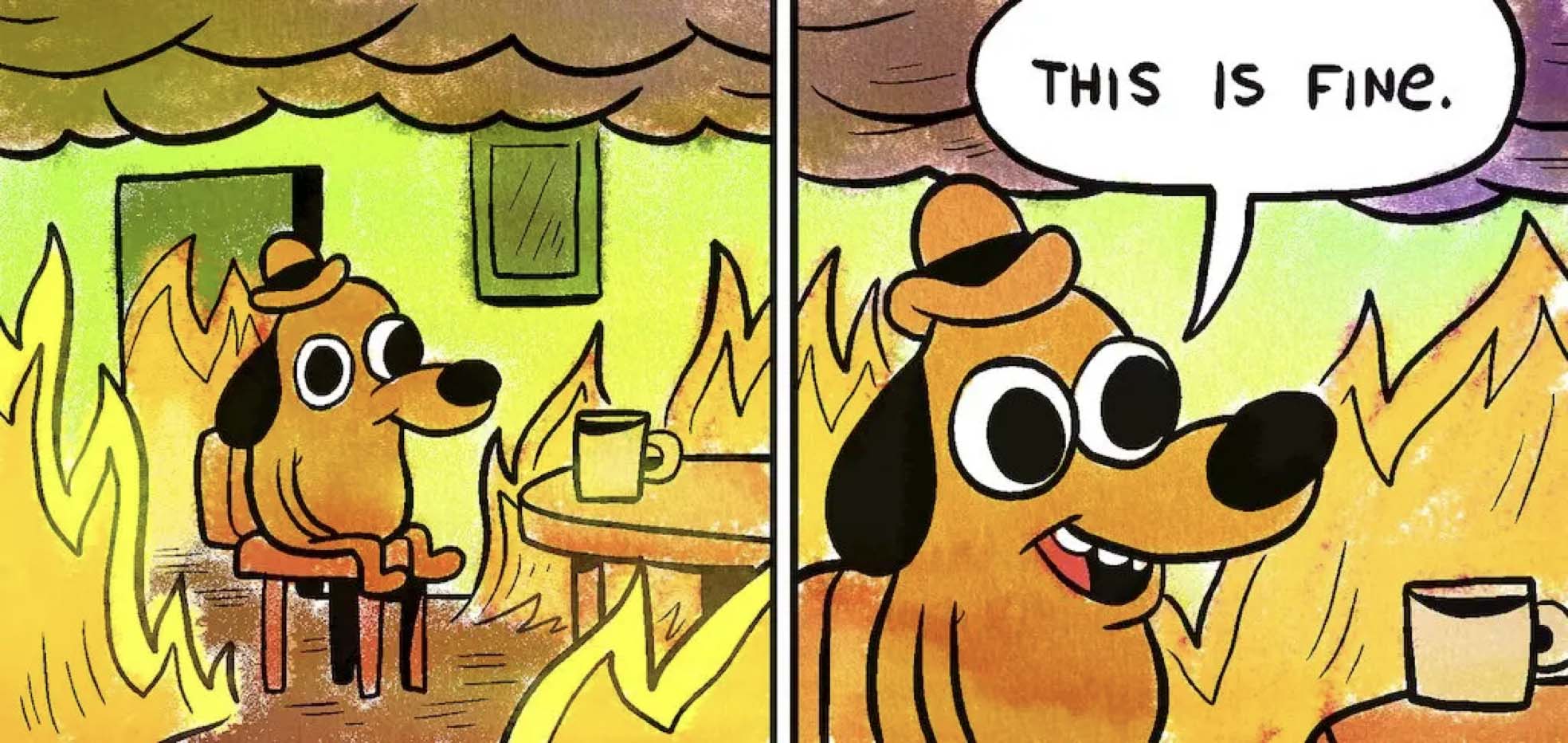
The second image is a comic strip. There’s a dog sitting at a table with a cup of coffee, and all around it the house is on fire, and a cloud of smoke hangs under the ceiling. The dog is wearing a little bowler hat, it has a stupid smile on its face, and it’s saying, “This is fine,” as huge flames close in around it.
This was drawn in 2013 by an artist named K.C. Green for his webcomic, it’s part of a 6-panel comic where the dog catches fire as he says, “I’m okay with the events that are unfolding currently”, “that’s okay, things are going to be okay”. Then his face melts off.
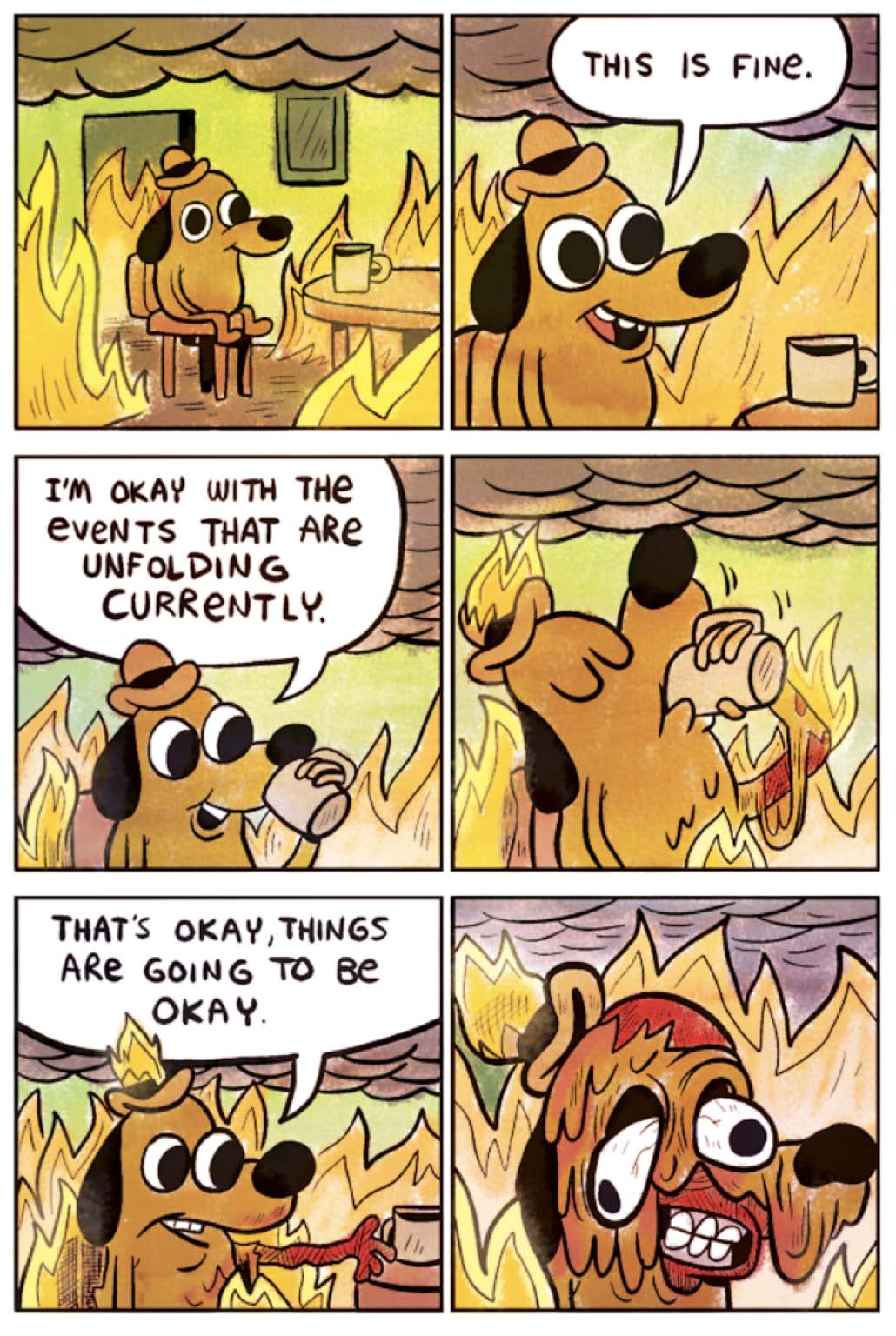
The first two panels became an Internet meme that people use to express, “You’re in denial. There’s a crisis of some sort and you should be panicking.”
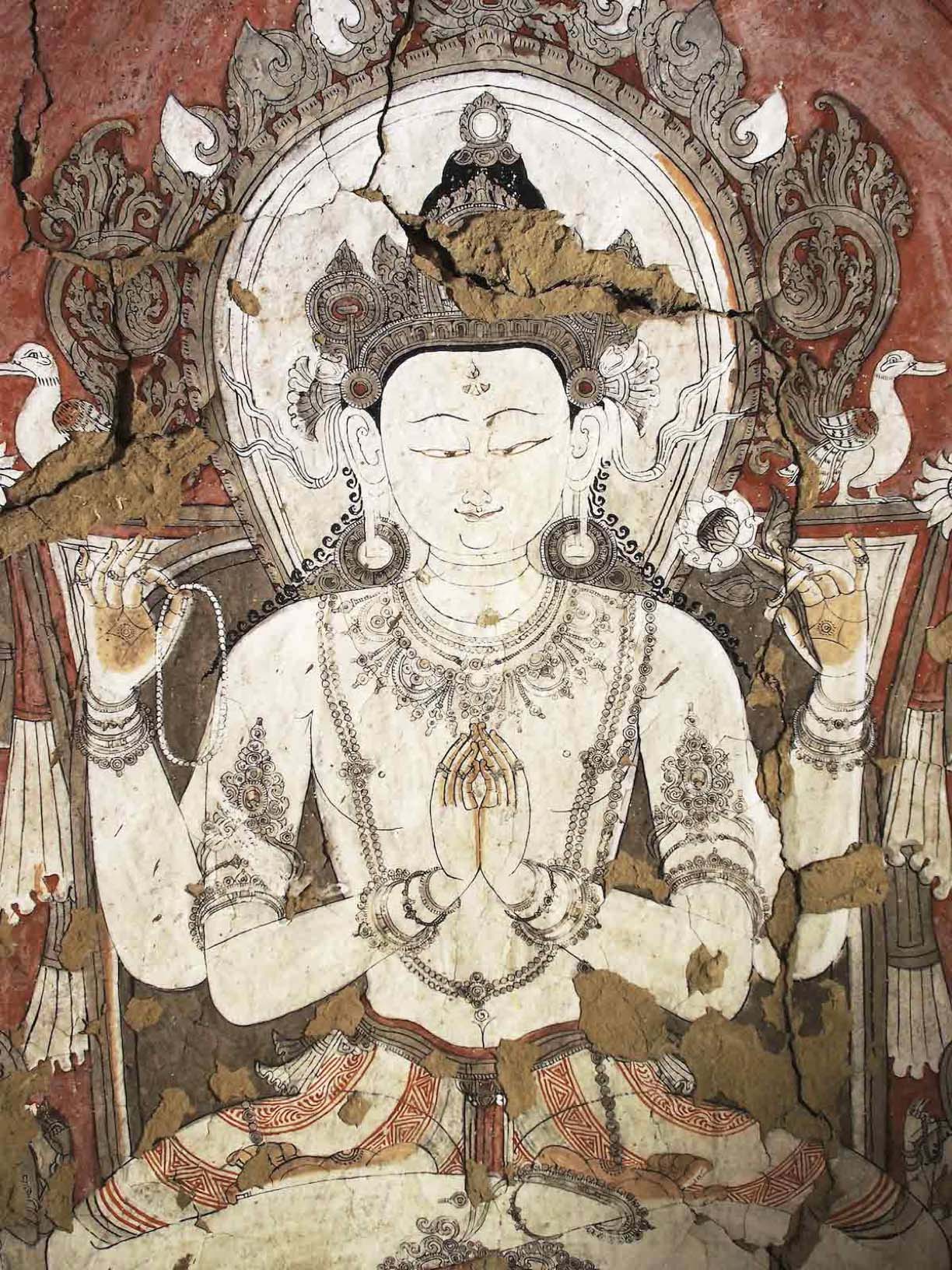
This is an image of Avalokiteshvara, painted on a cave wall in Nepal in the 12th Century. Avalokiteshvara’s name means literally “down-looking lord”. But, I learned that the name was originally Avalokitasvara—slightly different—and it meant “perceiving sound”, which is how we think of the Bodhisattva, as a being that hears the cries of the suffering world. This being was first mentioned in the Avatamsaka Sutra, written about 2000 years ago, where he appeared as male. In the Lotus Sutra, slightly later, Avalokiteshvara has many forms, both male and female.
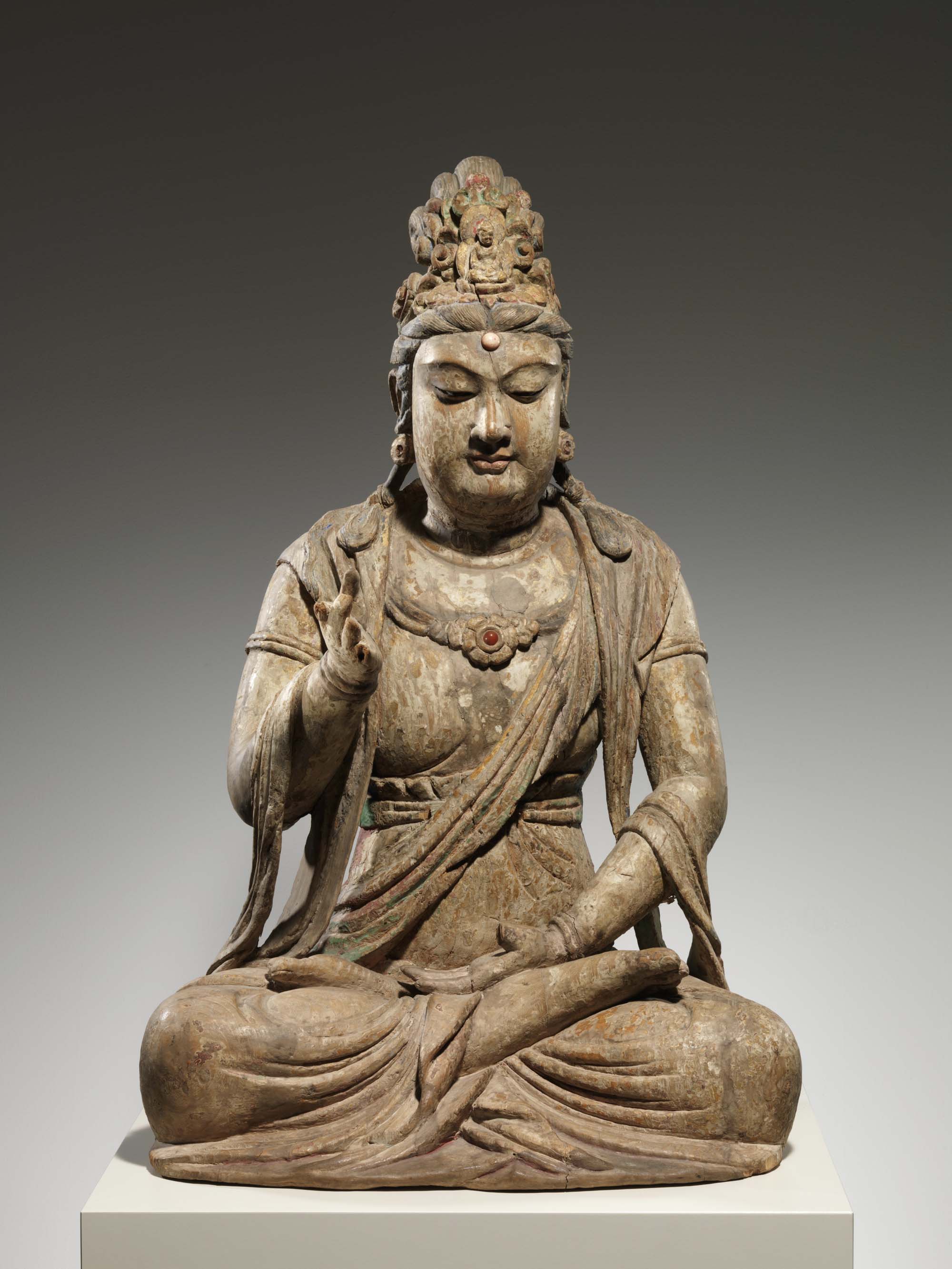
In China he or she is called Guanyin and can be male or female. This statue of Guanyin is at the Met, it was made in the 10th or 11th Century in China.
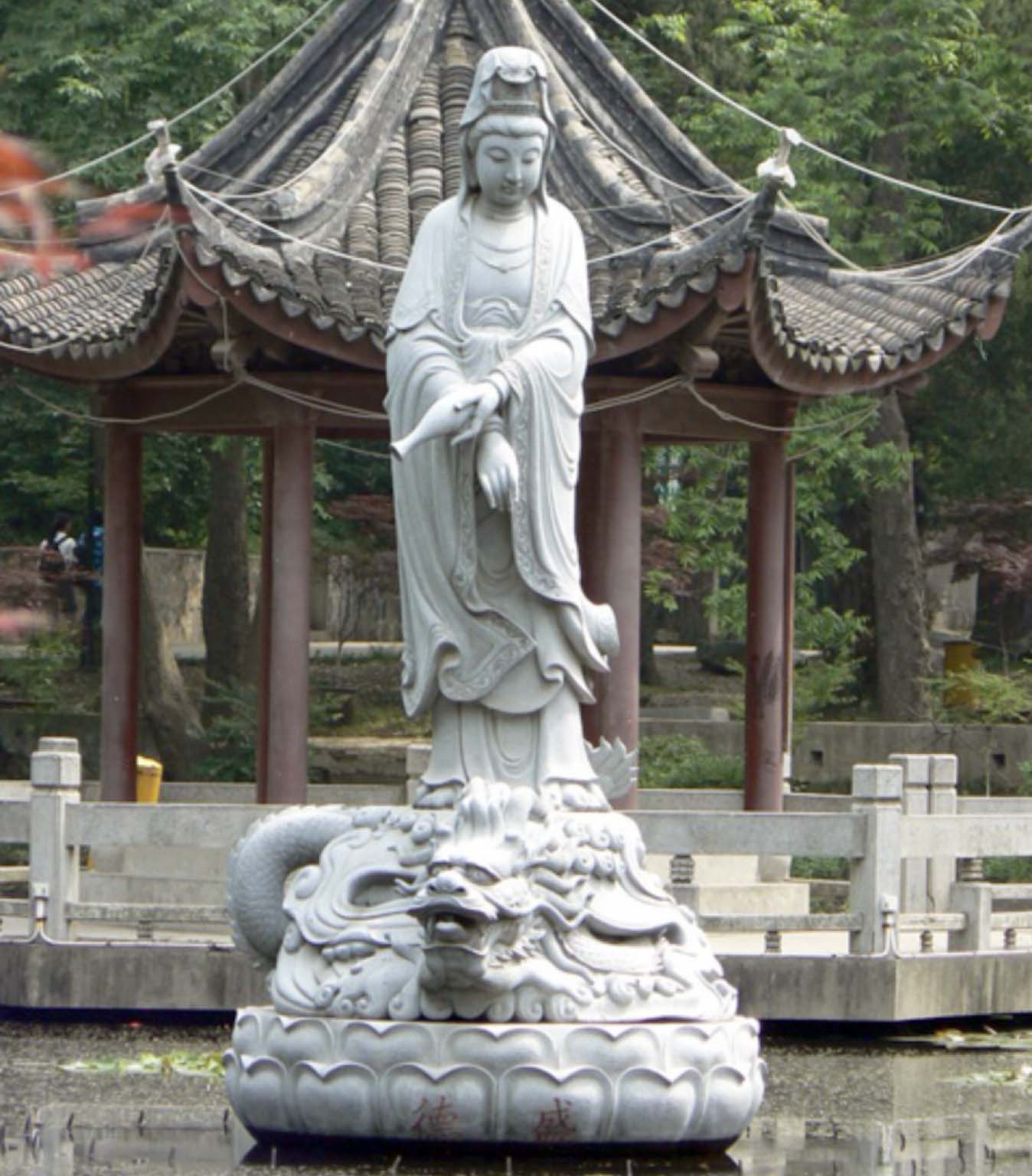
Here’s a contemporary statue. Here she’s pouring the water of compassion from a container.
In Japan, Guanyin is called Kanzeon or Kwanon or Kannon. The Canon camera company is named after her, by the way. Here’s an early Canon logo.

What I want you to notice is, even though Kanzeon hears the cries of all the suffering beings of the world, she’s smiling. Or at least, she looks peaceful. At the Village Zendo we are all on the Bodhisattva Path, we chant the Bodhisattva Vows, bodhisattvas like Kanzeon are our role models. So let’s ask ourselves: when we hear the cries of the suffering beings, are we smiling, or not?
Zenshin Caplow gave a terrific talk at the zendo a couple weeks ago, she focused on the courage of a bodhisattva. Please listen to that talk, it’s super insightful. Today, I’m not talking about courage, but about the cheerfulness of a bodhisattva!
Consider those three images: The Scream, or the oblivious dog in the burning house, or smiling Kanzeon. Which way are you?
I hear depression or exhaustion from a lot of people in the Village Zendo, and a lot of friends, and a lot of people who care about justice and democracy and the climate. What I don’t hear is people making it their goal to cheer up and enjoy their lives, despite the daily crises.
So I’m going to try to convince you to make the last image, the smiling Kanzeon, your role model. I want you to make it your goal to be cheerful and enjoy your life no matter what world events you hear about. I have three reasons why you should do this:
- The world isn’t going to hell.
- You’re a more effective bodhisattva if you’re cheerful.
- Emptiness.
Number one, the world isn’t going to hell. Do you think it is? Do you think we’re all going to die of global warming, or people are starving, or that the world is getting more violent? You can slice statistics in infinite ways, but overall, life has improved for nearly everyone, and it’ll probably continue to improve for a long time.
Global poverty is declining rapidly. There’s a statistic called the International Poverty Line, defined as living on less than $2.15 a day. The number of people below that line has decreased from nearly 40% of people in 1990 to less than 10% today, in other words the share of the population in extreme poverty is a quarter of what it was in 1990. In the same period infant mortality fell by half. Deaths from famine have become extremely rare compared to past decades.
As I say this, I’m aware that people are dying of hunger in Gaza right now. I’m not minimizing that. The opposite: I’m saying we must act to end hunger everywhere, and we should be encouraged, knowing that it’s possible, because we’ve nearly accomplished it.
Of course, the big negative trend is global warming. But it doesn’t mean the planet is going to burn up or we’re all going to die. The Intergovernmental Panel on Climate Change says the most likely scenario is 2 or 3 degrees Celsius of warming by the year 2100. That means we’re going to be hotter than the goal that they set, but not by too much, and it’s far better than the worst-case scenario. A lot of climate activists will cite scenarios where Manhattan is underwater and all of Africa is a desert, but that’s based on the IPCC’s worst-case scenario, and it’s now clear that won’t happen, partly because people are taking action! The US’s total carbon emissions, for example, have been falling since 2007. Plus, as countries get richer, they tend to use more efficient energy sources. And as countries get richer their population growth slows. The global population will probably peak in the year 2100 or sooner, and start shrinking after that, which should make it easier to reduce carbon emissions. Taking everything together, the IPCC projects that over the next century, despite global warming, global poverty will keep falling, hunger will be rarer, average lifespan will increase, standards of living will improve. Global warming is bad, but humanity’s progress continues anyway.
Of course there are crises. The last few years have been fairly violent, with wars between Russia and Ukraine, and between Israel and Hamas. And there have been a few other wars. Just as an example of how distorted our view can be, the Tigray War in Ethopia a few years ago was much bigger than the Israel-Hamas war but it was hardly covered by US media.
Kanzeon doesn’t lose her cool when a war breaks out. She knows there have been far more violent years in the 70s and 80s, and of course those years are dwarfed by WWI and WWII. Overall, wars between countries have become very rare compared to the 20th Century. And anyway, Kanzeon understands human nature, we’re prone to violence because we have greed, anger, and ignorance. So she expects there to be some wars from time to time. It doesn’t change her mission. Kanzeon just keeps working to wake us up.
If you think the world is going to hell, that’s your view, it’s arising in your mind. The world seems to be going to hell because of what you choose to focus on, and that is probably influenced by how you consume the news. And the news is influenced by media companies’ desparate need for your attention, it’s what they need to survive. Of course they focus on the negative! Global poverty keeps falling year after year, but media companies know that stories about continuous improvement don’t generate clicks. Be aware of this distortion and try to correct it, seek out good news, and seek out information about big, long-term trends, not the brief crises of the day.
Kanzeon sees the whole world over the long term, that’s why she keeps smiling through each crisis.
Number two, you’re a more effective bodhisattva if you’re cheerful.
If we imagine that today’s wars are unusually bad, it can seem like we’re losing the struggle for peace, and that’s discouraging. Or if we think we’re all doomed on a burning planet, that’s super discouraging. I hear people say there’s no point bringing children into a doomed world. Have children or don’t, I have no opinion, but make an informed decision: their lives will probably be better than ours. If we’re aware of the progress we’re making, towards peace, towards a carbon-neutral economy, towards global prosperity, that encourages us to keep trying!
There’s a story about Kanzeon, which of course has many versions, so here’s mine: Once upon a time, early in Kanzeon’s career, he had just one head and two arms. But he worked furiously hard and liberated countless beings from suffering. He paused, he looked around, and the number of suffering beings still seemed overwhelming. He was so frustrated his head exploded. Buddha put his head back together in a different form: it became 11 faces. A peaceful face to calmly gaze in each of the 10 directions, so Kanzeon wouldn’t lose track again. And on top of these 10 faces, Buddha placed an 11th face, a wrathful face for the suffering beings who need a kick in the ass to liberate them.
So Kanzeon went back into action. But trying to save all beings at once, he moved his arms so fast they shattered. So Buddha did some magical upgrades, and gave Kanzeon 1000 arms, and in each of his 1000 palms Buddha placed an eye, so Kanzeon could give individual attention to every being simultaneously.
But you and I are not 11-faced and 1000-armed. Generally we have one face each, and at most two arms. If I tried to respond to every crisis simultaneously, my head would explode and my arms would shatter. I need to remember that this body, this brain, is just one of Kanzeon’s hands and eyes. Or maybe I’m one of her fingers, maybe I’m one of her cells. I can’t do it all. So I focus where I think I’m effective: I lead the sangha at Sing Sing, I donate 10% of my income to GiveWell, which directs it to the most effective charities, like vitamins and vaccines to people in Africa. I support the Village Zendo and New Paltz Zen Center. I focus on a few things, and I’m satisfied. I am doing enough!
Kanzeon responds to all the cries of the world, no one and nothing is left out, and my actions are a part of that.
Since I’m doing enough, I don’t read too much news. I don’t need to know the ins and outs of US politics. I don’t need to follow the daily events of every war. It’s okay. I need to be informed, but I don’t need daily information to do my bodhisattva work. If I got daily information it would be bad for me.
If you take one piece of advice from this whole talk, it’s this: turn off news alerts on your phone. If Shakyamuni Buddha were here today, he’d make all his monks and nuns turn off their news alerts before he shaved their heads. It’s essential.
If you have an iPhone, here’s how to do it. Open Settings, search for whatever news app is sending you alerts, like maybe the NYTimes app, then tap Notifications and turn them off. If you have an Android or a smartwatch, I’m sure it’s equally easy. It is so important that you do this.
You might be wondering, how can a bodhisattva ignore the daily news? What about bearing witness? Bearing witness is one of the tenets of the Zen Peacemaker Order, which we belong to. We occasionally recite these tenets and vow to follow them. So am I allowed to focus on a few things, and turn off the news? Yes I am! Bearing witness is intimate. It’s being fully present with someone. You have to enter their world and experience it with them. You can’t do that if you’re being interrupted by New York Times headlines. The headlines are a media company’s interpretation of the world. Bearing witness is a direct experience. The two things could not be more different. If you turn off the news it gives you space to bear witness, and I find that when I do bear witness, it fulfills me and gives me courage to act, cheerfully!
So that was number two, a cheerful bodhisattva is an effective bodhisattva. My third and final argument why you should try to be cheerful is: emptiness. Nothing is separate or solid, it only briefly appears that way. Beings appear and disappear constantly, like waves rise up from the ocean and fall back into it. Fairly soon, everyone in this room and this Zoom call will die. Later, the sun’s fusion reaction will use up all its hydrogen, and it will start fusing helium instead; it will heat up and destroy the earth. If humanity escapes the earth, we could survive a while longer, but some day the whole universe will run out of energy and become cold and silent and everything will die.
What I like about Buddhism is that we face the facts. We practice accepting death. Unlike the oblivious dog saying “this is fine”, we do see the flames and we know what’s going to happen. But we accept it, because the beings that appear and disappear are just waves in the ocean. They are empty of meaning as individuals, they are inseparable parts of the magnificent whole. The knowledge of this fact is called prajna paramita, “wisdom perfected”. As the Heart Sutra tells us, Avalokiteshvara practices prajna paramita! The paradox of being a bodhisattva is to value each individual and care about their well-being, without ever forgetting that we are each just a momentary expression of the whole shebang, never really separate. When we see this, our own peace of mind is stable, it doesn’t depend on anything, certainly not on the daily news cycle.
As Samantabadhra Bodhisattva says in the Avatamsaka Sutra:
Even though the void of space, together with the states of beings, with the karmas of beings, with the sorrows of beings, though all these will end, yet my approval and joy in the merits of all beings will not end.
Samantabadhra isn’t depressed by the thought of the end of the world, actually he sounds ecstatic, because he knows his joy doesn’t depend on anything but his vow.
So I’ve argued that the bodhisattva path is cheerful action and enjoying our lives. The bodhisattva vow isn’t vowing to be depressed about the state of the world, it’s vowing to be like Kanzeon—both in our attitude and in our action. Think again about those three images, the scream, the oblivious dog, the smiling bodhisattva. If you feel more like screaming than smiling, ask yourself: what about my practice is having this result? What might I do differently to have a different result?
The hardest news for me to handle, lately, is the likelihood that Trump will be reëlected. But I do not intend to be anxious about it. My method is, instead of obsessively reading news coverage, I’m just doing what I can. Keishin and I will lead a fundraiser for Biden this fall, we did this in 2020 and helped raise tens of thousands of dollars, and we’ll do that again. And I’ll take September and October off work and look for ways to volunteer for Democrats. My local congressman is a Democrat. We’re in a swing district here, he won by one percent last year, so working for his reëlection is a high-leverage way to make a difference. Electing Democrats seems like the most effective way to combat global warming and protect human rights. We all know Democrats are far from perfect, but it looks like the bodhisattva path to me.
It’s my experience that obsessing about politics is depressing, but participating in politics is really fun and satisfying. So I’ll do what I can during this campaign, and then I’ll move on and enjoy my life. A bodhisattva is never stuck, a bodhisattva’s action is always flowing.
If Trump wins, I don’t intend to be depressed about it. I’ll keep up with the news as much as is useful, and that’s it. I’ll cheerfully work to contain the damage however I can, and I’ll move on and enjoy my life. I won’t get stuck, and I won’t fall apart.
I’ll leave you with a verse by Enkyo Roshi, from her book “A Little Bit of Zen”:
We can’t lose our heads.
Oh, Bodhisattva!
Losing your head doesn’t help—
Instead, extend your hand.
Offer your words, your wisdom, your effort.
That’s what a Bodhisattva does, day in and day out.
Serving all of life.